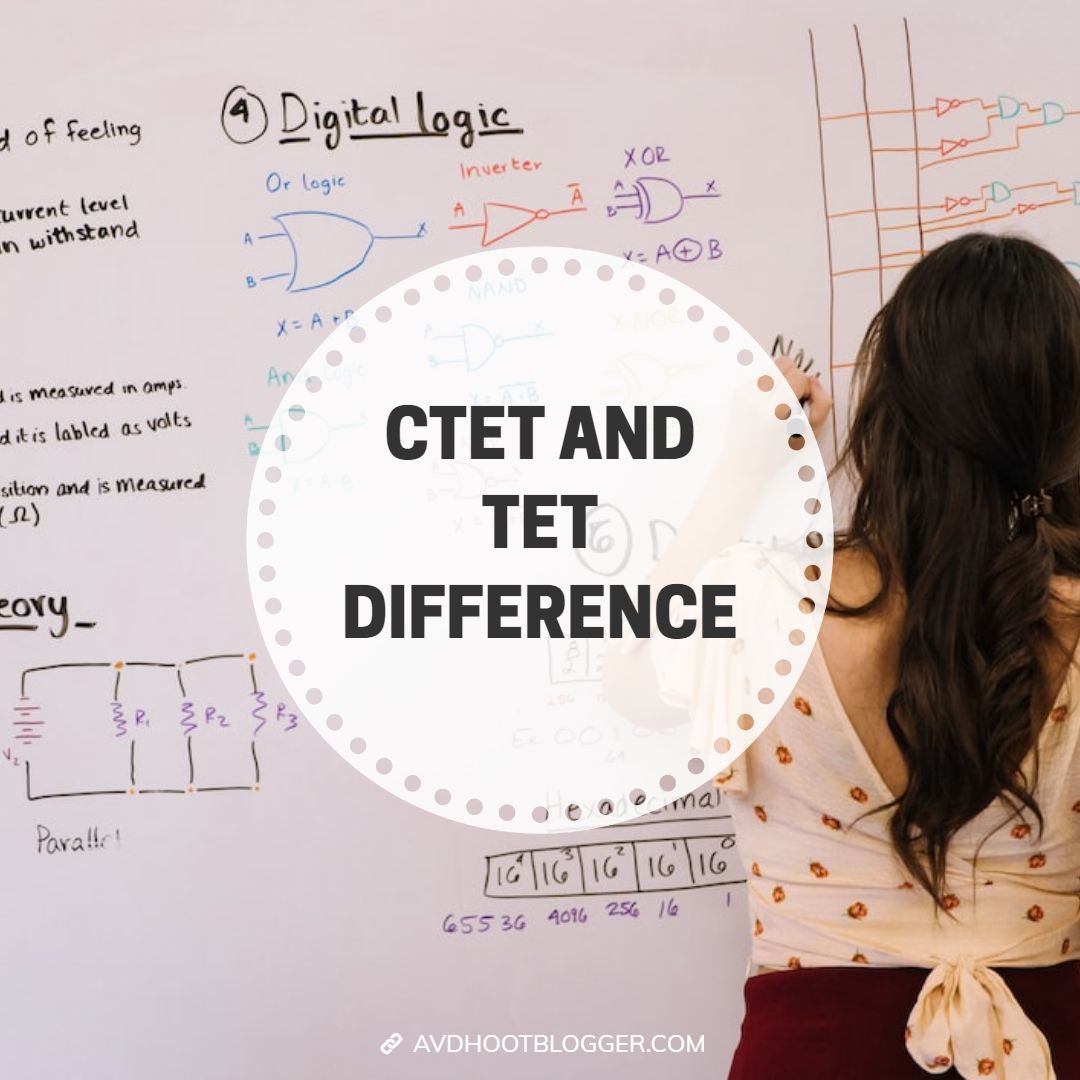CTET and TET Difference
CTET and TET Difference
CTET and TET are two popular teacher eligibility tests in India. These exams play a crucial role in determining the eligibility of candidates to become teachers in various schools. While CTET stands for the Central Teacher Eligibility Test, TET stands for the Teacher Eligibility Test. In this article, we will explore the differences between CTET and TET, including their eligibility criteria, exam patterns, job opportunities, and more.

Article Outline
-
Introduction
- What is CTET?
- What is TET?
- Importance of CTET and TET
-
Eligibility Criteria
- CTET eligibility criteria
- TET eligibility criteria
-
Exam Pattern and Syllabus
- CTET exam pattern and syllabus
- TET exam pattern and syllabus
-
Validity and Certification
- CTET validity and certification
- TET validity and certification
-
Job Opportunities
- CTET job opportunities
- TET job opportunities
-
Salary and Benefits
- CTET salary and benefits
- TET salary and benefits
-
Preparation Tips
- CTET preparation tips
- TET preparation tips
-
Challenges and Difficulties
- Challenges of CTET
- Difficulties faced in TET
-
Comparison
- Key differences between CTET and TET
- Similarities between CTET and TET
-
Conclusion
-
FAQs
- CTET or STET: Choosing the Right Teaching Eligibility Exam
- CTET vs. B.Ed.: Choosing the Right Path for Your Teaching Career
- CTET vs KVS: Making the Right Choice for a Teaching Career
- CTET vs NET: Understanding the Difference
- CTET vs. REET: Understanding the Differences and Making the Right Choice
Introduction
The field of education demands qualified and competent teachers who can provide quality education to students. To ensure the recruitment of capable individuals, teacher eligibility tests like CTET and TET are conducted. These exams assess the knowledge and teaching abilities of aspiring teachers. Let’s delve into the details of both tests.
What is CTET?
CTET, which stands for the Central Teacher Eligibility Test, is a national-level examination conducted by the Central Board of Secondary Education (CBSE). It is a mandatory test for candidates aspiring to become teachers in central government schools, including Kendriya Vidyalayas and Navodaya Vidyalayas. CTET consists of two papers: Paper I for primary stage (classes I to V) and Paper II for elementary stage (classes VI to VIII).
What is TET?
TET, on the other hand, refers to the Teacher Eligibility Test, which is conducted by respective state education boards. TET is applicable for candidates who want to become teachers in state government schools. Each state in India has its own TET examination, and the eligibility criteria, exam pattern, and syllabus may vary from state to state.
Importance of CTET and TET
Both CTET and TET hold immense significance in the field of teaching. They ensure that teachers possess the required knowledge, skills, and understanding to educate students effectively. These exams establish a benchmark for the recruitment of qualified teachers, thereby enhancing the overall quality of education in schools.
Eligibility Criteria
To appear for CTET or TET, candidates need to fulfill specific eligibility criteria set by the respective conducting authorities. Let’s explore the eligibility requirements for both exams.
CTET Eligibility Criteria
To be eligible for CTET, candidates must meet the following criteria:
-
For Paper I (Classes I to V):
- Should have completed 10+2 with at least 50% marks and passed or appearing in the final year of a 2-year Diploma in Elementary Education (D.El.Ed).
- Or, should have completed 10+2 with at least 45% marks and passed or appearing in the final year of a 2-year Diploma in Elementary Education, in accordance with the NCTE Regulations.
- Or, should have completed 10+2 with at least 50% marks and passed or appearing in the final year of a 4-year Bachelor of Elementary Education (B.El.Ed).
- Or, should have completed 10+2 with at least 50% marks and passed or appearing in the final year of a 2-year Diploma in Education (Special Education).
-
For Paper II (Classes VI to VIII):
- Should have completed a graduation degree and passed or appearing in the final year of a 2-year Diploma in Elementary Education (D.El.Ed).
- Or, should have completed a graduation degree with at least 50% marks and passed or appearing in 1-year Bachelor in Education (B.Ed).
- Or, should have completed a graduation degree with at least 45% marks and passed or appearing in 1-year Bachelor in Education (B.Ed), in accordance with the NCTE Regulations.
- Or, should have completed a graduation degree with at least 50% marks and passed or appearing in 1-year B.Ed. (Special Education).
TET Eligibility Criteria
The eligibility criteria for TET may vary from state to state. Generally, the minimum requirements include:
-
For Paper I (Classes I to V):
- Should have completed 10+2 with at least 50% marks and passed or appearing in the final year of a 2-year Diploma in Elementary Education (D.El.Ed).
- Or, should have completed 10+2 with at least 50% marks and passed or appearing in the final year of a 4-year Bachelor of Elementary Education (B.El.Ed).
- Or, should have completed 10+2 with at least 50% marks and passed or appearing in the final year of a 2-year Diploma in Education (Special Education).
-
For Paper II (Classes VI to VIII):
- Should have completed a graduation degree with at least 50% marks and passed or appearing in a 1-year Bachelor in Education (B.Ed).
- Or, should have completed a graduation degree with at least 45% marks and passed or appearing in a 1-year Bachelor in Education (B.Ed), in accordance with the NCTE Regulations.
Please note that these are general eligibility criteria, and candidates should refer to the official notifications and guidelines of the respective conducting authorities for precise details.
Exam Pattern and Syllabus
Understanding the exam pattern and syllabus is crucial for effective preparation. Let’s take a closer look at the exam pattern and syllabus of both CTET and TET.
CTET Exam Pattern and Syllabus
CTET consists of multiple-choice questions (MCQs) with four options. The exam pattern for both Paper I and Paper II is as follows:
-
Paper I:
- Total marks: 150
- Number of questions: 150 (each carrying 1 mark)
- Duration: 2.5 hours
- Sections: Child Development and Pedagogy, Language I, Language II, Mathematics, and Environmental Studies
-
Paper II:
- Total marks: 150
- Number of questions: 150 (each carrying 1 mark)
- Duration: 2.5 hours
- Sections: Child Development and Pedagogy, Language I, Language II, Mathematics and Science (for Mathematics and Science teachers) or Social Studies/Social Science (for Social Studies/Social Science teachers)
The syllabus for CTET covers topics related to child development and pedagogy, language proficiency, and subject-specific knowledge based on the chosen paper.
TET Exam Pattern and Syllabus
TET exam pattern and syllabus may vary among different states. Generally, the exam pattern consists of MCQs. The syllabus includes topics related to child development and pedagogy, language proficiency, mathematics, science, and social studies. Candidates should refer to the official notifications of their respective state TET for detailed information.
Validity and Certification
Clearing CTET or TET exams leads to the attainment of a teacher eligibility certificate. Let’s understand the validity and certification aspects of both CTET and TET.
CTET Validity and Certification
The CTET certificate is valid for seven years from the date of declaration of the result. It is renewable, and candidates can appear for the exam again to improve their scores. The certificate is issued by the CBSE and serves as eligibility for teaching positions in central government schools.
TET Validity and Certification
The validity period of the TET certificate varies from state to state. Generally, it is valid for a certain number of years from the date of issuance. Candidates can renew or update the certificate as per the guidelines of the respective state education boards. The TET certificate is necessary for candidates seeking teaching positions in state government schools.
Job Opportunities
Clearing CTET or TET opens up various job opportunities for aspiring teachers. Let’s explore the potential career prospects for candidates who qualify these exams.
CTET Job Opportunities
Candidates who clear CTET become eligible to apply for teaching positions in central government schools, including Kendriya Vidyalayas (KVs) and Navodaya Vidyalayas (NVs). These schools are renowned for their quality education and offer a stable and rewarding career to teachers.
TET Job Opportunities
TET-qualified candidates can apply for teaching positions in state government schools. Each state conducts its own recruitment process for hiring teachers based on TET scores. These schools provide opportunities for teachers to contribute to the education system at the state level.
Salary and Benefits
The salary and benefits of teachers who clear CTET or TET vary based on factors such as the type of school, experience, and qualifications. Let’s explore the general salary structure and benefits associated with these positions.
CTET Salary and Benefits
Teachers employed in central government schools, such as KVs and NVs, receive competitive salaries and benefits. The salary may range from Rs. 35,000 to Rs. 65,000 per month, depending on the level of experience and qualifications. Other benefits include health insurance, retirement benefits, paid leaves, and allowances.
TET Salary and Benefits
Teachers working in state government schools receive salaries as per the norms and regulations of the respective state governments. The salary may range from Rs. 25,000 to Rs. 50,000 per month, depending on factors such as experience, qualifications, and location. Additional benefits and allowances vary among states.
Preparation Tips
Preparing for CTET or TET requires a strategic approach and thorough understanding of the exam syllabus. Here are some helpful tips to enhance your preparation:
CTET Preparation Tips
- Understand the exam pattern and syllabus thoroughly.
- Create a study plan and allocate sufficient time for each subject.
- Refer to NCERT textbooks and other reliable study materials.
- Solve previous years’ question papers and take mock tests for practice.
- Stay updated with current affairs and educational developments.
- Join online forums or study groups to discuss concepts and clarify doubts.
- Practice time management during the exam to improve speed and accuracy.
TET Preparation Tips
- Familiarize yourself with the exam pattern and syllabus specific to your state TET.
- Gather relevant study materials and resources recommended by experts.
- Focus on strengthening subject knowledge and pedagogical concepts.
- Solve sample papers and practice previous years’ question papers.
- Take online quizzes and participate in mock tests to assess your preparation.
- Seek guidance from experienced teachers or mentors for effective study strategies.
- Stay updated with state-specific educational policies and reforms.
Challenges and Difficulties
Clearing CTET or TET exams may come with certain challenges and difficulties. It’s important to be aware of these factors to overcome them effectively.
Challenges of CTET
- High competition: CTET witnesses a large number of applicants, making the competition intense. Candidates need to prepare thoroughly to stand out from the crowd.
- Comprehensive syllabus: The vast syllabus of CTET requires candidates to cover a wide range of topics, demanding systematic and diligent preparation.
- Time management: The duration of the CTET exam is limited, so managing time efficiently and answering questions accurately can be challenging.
Difficulties faced in TET
- Varied syllabus: Each state TET has its own syllabus, which may differ from the central syllabus. Adapting to state-specific topics and preparing accordingly can be a challenge.
- State-specific language requirements: Some states conduct TET exams in regional languages, making it essential for candidates to have proficiency in the specified language.
- Limited vacancies: The number of teaching vacancies in state government schools may be limited, increasing the competition among candidates.
Comparison
Let’s highlight the key differences and similarities between CTET and TET:
Key differences between CTET and TET:
- Conducting authority: CTET is conducted by the CBSE at the national level, while TET is conducted by respective state education boards.
- Eligibility criteria: The eligibility criteria for CTET and TET may vary, with CTET having specific criteria for central government schools and TET having criteria defined by individual states.
- Validity: CTET certificate is valid for seven years, whereas the validity of TET certificates depends on state regulations.
- Job opportunities: CTET opens doors to teaching positions in central government schools, while TET qualifies candidates for state government school jobs.
- Salary structure: The salary and benefits of teachers may differ between central and state government schools.
Similarities between CTET and TET:
- Purpose: Both CTET and TET aim to assess the eligibility of candidates for teaching positions.
- Exam pattern: Both exams follow an MCQ-based pattern, testing candidates on various subjects related to education and pedagogy.
- Syllabus: Both exams cover topics such as child development, pedagogy, language proficiency, and subject-specific knowledge.
- Preparation approach: The preparation strategies for CTET and TET involve studying the syllabus, practicing sample papers, and taking mock tests.
Conclusion
In conclusion, CTET and TET are crucial teacher eligibility tests that play a significant role in the recruitment of qualified teachers in India. While CTET is conducted at the national level for central government schools, TET is conducted by state education boards for state government schools. Understanding the eligibility criteria, exam pattern, and syllabus is essential for effective preparation. Both CTET and TET provide rewarding job opportunities in the field of teaching, contributing to the overall improvement of the education system.




Excellent blog…this article very helpful for all of us…